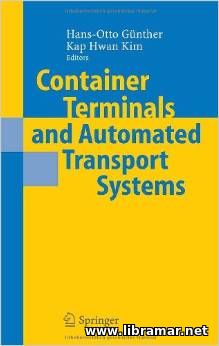 The maritime container transportation has grown significantly in the last forty plus years. As a result of that, it become an important mode of the intercontinental cargo traffic. Container terminals always played a major role as the multimodal interfaces between land and sea transport. The dimensions of the container vessels have dramatically increased during the last decade, in order to benefit from the scale economy.
Some of the large container vessels may require thousands of lifts in a seaport cargo container terminal during a single call. Taking into account the fact that the container carrier involves huge capital investment as well as high daily operating costs, customer service is now a critical issue for the seaport terminals - as a results, so many terminals are making attempts to improve the throughput and reduce the turn-around time. The containerization is growing constantly, and the number of port terminals is increasing, correspondingly.
As it is meant by the name, the aim of this publication is to reflect the major latest developments and also to present the most important insights; in addition to that, the efforts were made by the authors to check the various successful solutions to the existing operational problems of the transportation systems and terminals.
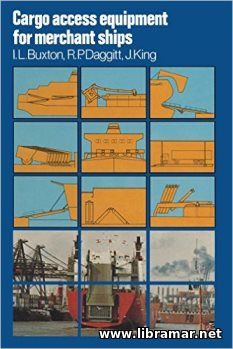 The cargo access equipment used on board vessels include hatch covers, ramps and elevators, doors (bow, stern and side) as well as movable decks, and all of them serve the purpose of facilitating the cargo loading and discharging operations. In total, the equipment listed above may account for about ten percent of the initial cost of the ship.
And, despite of the huge importance, which is enhanced by the developing Ro-Ro shipping, no decent publication n this matter has ever been released. In this publication, we are trying to deal with all aspects of shipboard cargo access, including the description of the basic equipment, design requirements, economic aspects of selection and operation of the cargo access equipment, ad, of course, performance in service issues. Some useful material relating to the weights and stowage requirements, has also been added to the contents of the book.
Apart from that, there is some background information included on vessel types and cargo handling techniques. Note that the authors did not confine it to MacGregor products - the material included was drawn from all over the world. Though the editors are not specialists in this sort of equipment, their experience in ship design and operation and their engineering background make this book very helpful and practical.
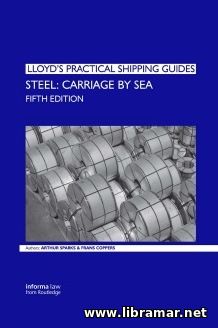 The present practical publication belongs to the series of guides released by Lloyd's. It is intended to provide readers with valuable advice that will help them in preventing claims commonly arising during the marine transportation of steels - these would include careful handling of the steel cargo, instructions for correct stowage and due care of the cargo throughout the whole journey.
The publication is covering every single important aspect of the marine transportation and is also providing some tips on how to conduct the survey of the steel products carried on board ships. The readers will know how to prevent possible damages to the cargo, how better deal with the claims, get familiarized with the manufacture of different steel products including packaging requirements for each particular type of steel product.
They will also receive professional instructions and guidance on the loading, stowage, lashing, securing and ventilation as well as on conducting proper maintenance of the hatch covers and tank tops including corrosion problem. The cargo documentation has also been dealt with together with surveying and handling of any claims. An excellent guidebook that shall be readily available on board.
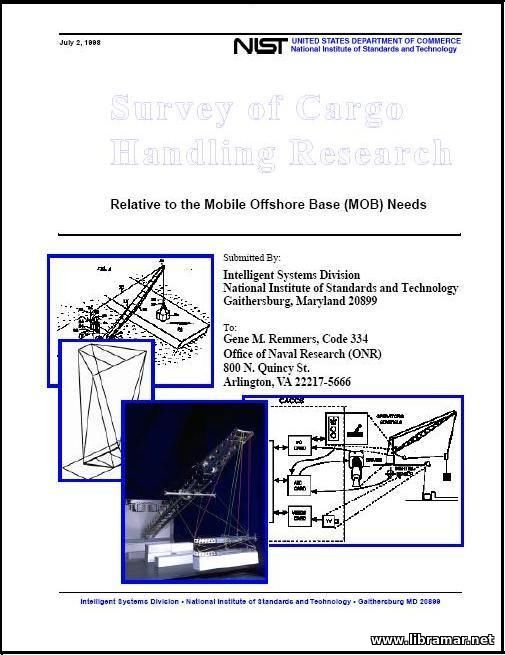 The full name of this document is Survey of Cargo Handling Research Relative to the MOB (Mobile Offshore Base) needs. Subject research was performs and results released by the National Institute of Standards and Technology (NIST). The MOB management team of the ONR (Office of Naval Research) considered crane development a critical technology required for any feasible mobile offshore base.
Subsequently, they requested the NIST to asses the present-day state of practice in the field of crane automation as well as motion compensation. The present survey report is aimed to set a baseline and identify any further research required in order to satisfy the gaps in the technology, should any of the be revealed. The survey scope includes cranes and any other auto-technology utilized when performing the LO/LO transfer of cargo, including the containers. The authors made the emphasis on the containers transfer between the container vessels and mobile offshore bases.
The issues related to the loading/unloading cargo brought by air are not dealt with in this report. the requirements applicable to the mobile offshore base cranes have mostly be developed in the NIST lab researches; however, some additional input was made by various developers of the MOB concept...
 This Guide was developed and released by the professionals of the Wallenius Wilhelmsen company, one of the world leaders in the field of the marine cargo transportation. The booklet is divided into three basic parts, namely Handling, Static Cargo, and Equipment.
The Company carries huge volumes of static cargo all around the world, including machinery items, which require very careful hndling fue to the electronics fitted. The cargo to be transported is usually stowed on rolltrailers; however, the bolsters are also in use for the relatively small cargoes. In turn, bolsters and rolltrailers are secured to the ship's deck. The transporters must give due care and consideration to the details of cargo securing in order to avoid any possible mechanical stress since this can easily result in the damage to the cargo. Please note that this publication shall not be treated as the textbook; this is rather the booklet describing the company's experience and outlining some major static cargo transportation techniques.
However, it will definitely be useful for people involved in marine transportation of cargoes since the techniques contained in it are worth having a look. It also addresses such issues as moving the cargo across land and sea, and bringing distances from shore to the sea
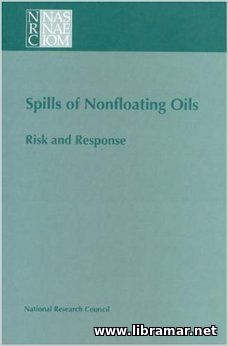 Nowadays, maritime accidents resulting in oil spills are on the very top of the list of public environmental concerns. Such oil spills are extremely difficult to control and they may eventually contaminate the marine environment. Once the oil is spilled, it immediately undergoes significant chemical, physical and biological changes, being degraded by the bacteria. And the most serious problem is that most of the modern technologies of spill recovery, that are used today, are not too effective.
In case of an oil spill, only ten or fifteen percent of the oil is usually recovered with the best rates being about thirty percent - for sure, that is too far from satisfactory figures. The main objectives of the present work are to assess the most important threats that are posed by transportation of the "heavy" oil (i.e. one with the specific gravity >1) by sea and to assess the adequacy of the existing cleanup technologies, to recommend the new researches in order to develop new cleanup techniques, to identify the barriers to the most effective responses to the oil spills and recommend the measures (financial, management or technological) that would assist in promoting prompt and effective responses to the "heavy" oil spills...
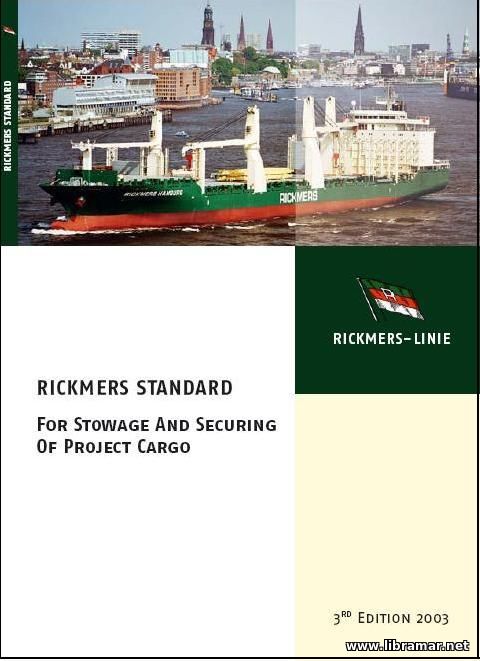 The present Standard shall be considered the basic source reference of proper planning, safe handling and stowage, as well as securing and lashing of project cargoes. It is applicable to all vessels and forms a part of Rickmers-Linie QMS. Its declared purpose and spirit is to get the ship owners, stevedores and, in fact, any other involved parties informed about the safe cargo securing and handling techniques.
All technical details of this Standard fully comply with the IMO Res. A.714(17), as amended. The document, in particular, is intended to provide detailed info on the lifting, bedding, securing and lashing of transported cargo and also deals with the equipment utilized; the maintenance related issues have also been addressed. The cargo information that must be supplied by the shippers as per SOLAS Chapter IV reg. 2, has also been described in this standard, together with the required configuration of bedding areas, securing points and lifting provisions.
These aspects are to correspond with the tensile strength of the securing gear on board of the vessel as well as the deck layout. In case the requirements stated in this Standard cannot be met, an alternative solution providing the equivalent safety level is to be applied.
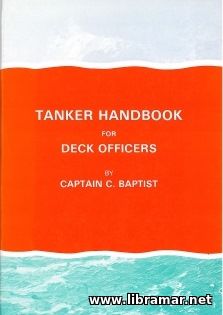 With the expansion that happened to the world energy over the past century the oil has become the major player, capable of meeting all the energy needs. Before that, coal used to be the main fossil; however, oil started to play more and more important role as it is easier to store and handle.
This revised and updated edition of the Handbook addresses the most important developments in oil tankers and the equipment utilized for handling the oil; the chemical and LNG tankers are also covered. Nowadays, marine transportation of oil is a vast industry and the importance of safety matters caused a huge number of national and international regulations to be developed and implemented.
All those regulations are updated on the regular basis and all crew members are obliged to be familiar with them and get all necessary training in order to meet the requirements. Quite a lot time passed since first edition of this book was released; the author tried to retain most part of the material related to the older ships even in the new releases of the Handbook, for broader view and proper understanding of the subject. In this latest edition the COW systems have also been covered due to their input in the environment protection.
|







